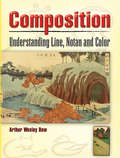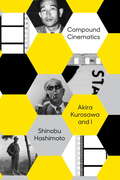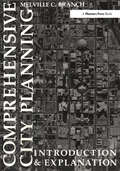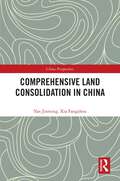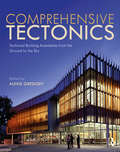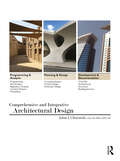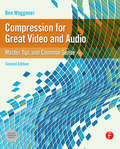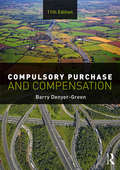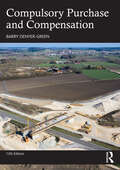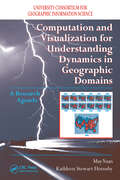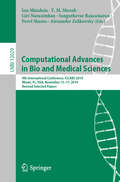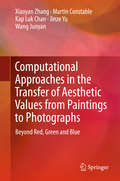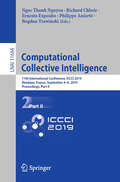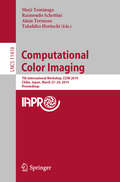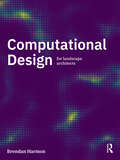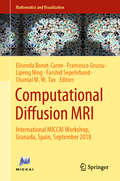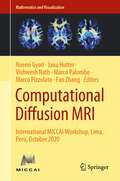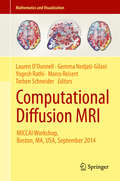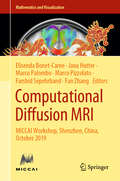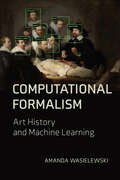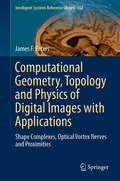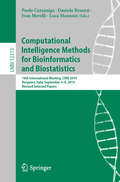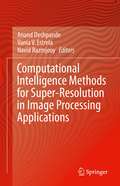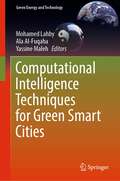- Table View
- List View
Composition: Understanding Line, Notan and Color (Dover Art Instruction Ser.)
by Arthur Wesley DowAt the turn of the twentieth century, Arthur Wesley Dow literally "wrote the book" on composition—and this is it! Dow's Composition exercised an enormous influence on emerging modern artists of a century ago. A thought-provoking examination of the nature of visual representation, it remains ever-relevant to all the visual arts.A well-known painter and printmaker, Dow taught for many years at Columbia University and acted as a mentor to countless young artists, including Georgia O'Keeffe. His text, presented in a workbook format, offers teachers and students a systematic approach to composition. It explores the creation of freely constructed images based on harmonic relations between lines, colors, and dark and light patterns. The author draws upon the traditions of Japanese art to discuss a theory of "flat" formal equilibrium as an essential component of pictorial creation. Practical and well-illustrated, this classic guide offers valuable insights into modern design.
Compound Cinematics
by Shinobu HashimotoAny list of Japan's greatest screenplay writers would feature Shinobu Hashimoto at or near the top. This memoir, focusing on his collaborations with Akira Kurosawa, a gifted scenarist in his own right, offers indispenable insider account for fans and students of the director's oeuvre and invaluable insights into the unique process that is writing for the screen. The vast majority of Kurosawa works were filmed from screenplays that the director co-wrote with a stable of steller writers, many of whom he discovered himself with his sharp eye for all things cinematic. Among these was Hashimoto, who caught the filmmaker's attention with a script that eventually turned into Roshamon. Thus joining Team Kurosawa the debutant immediately went on to paly an integral part in developing and writing two of the grandmaster's most impressive achievements, Ikiru and Seven Samurai.
Compound Polyhedra: Modular Origami
by Fergus CurrieA book of ten geometric models of advanced modular origami designed by Fergus Currie with full instructions and diagrams on how to make the following: 1.The Compound of Two Cubes2.The Compound of Two Tetrahedra3.The Compound of the Octahedron and the Cube4.The Compound of Three Cubes5.The Compound of Five Octahedra6.The Compound of Three Octahedra7.The Compound of Three Tetrahedra8.The Compound of the Icosahedron and the Dodecahedron9.The Small Triambic Icosahedron (STI)10.and11.The Compound of the STI and the Dodecahedron.It also includes an introduction with sections on the mathematics behind the models; a short history of modular origami; a section on tools and folding techniques, and a gallery of the finished models that are presented in the book.
Comprehensive City Planning: Introduction & Explanation
by Melville BranchThe author’s classic text focuses on the development of cities and how they have been planned and managed through the ages. The tie between land use and municipal administration is explored throughout. Topics include the roots of city management and planning; physical and socioeconomic views of cities; how city planning works within city government; the ties between planning and city politics; zoning and urban design; new towns; and regional planning. This work is the culmination of the author's long career in planning practice. His involvement in government, business, and academics means this book relates to a wide variety of fields. And the author writes in a clear, nontechnical style. Whether you're a city official, a professional, or a concerned citizen, you'll find this a cohesive, readable, and authoritative introduction to the field of planning.
Comprehensive Land Consolidation in China (China Perspectives)
by Yan Jinming Xia FangzhouThis book systematically investigates the strategy and practice of comprehensive land consolidation in China by assessing the objective of the program and its implementation.In the first part of the book, the authors first review the development and historical policy of land consolidation and land rehabilitation, with a focus on initiatives inaugurated in China since the 1980s. The following three chapters analyze different modes, approaches, and measures of land consolidation. The second part focuses on planning patterns designed and implemented in different territorial and geographical regions in China, including urban and rural areas, ecological function zones, mining areas, and coastal regions and islands. It also looks into the institutional basis, supportive measures, and mechanisms for the coordinated regional implementation of land consolidation at the macro, medium, and micro levels. Based on their findings, the authors advance ten actionable policy suggestions on the promotion of China’s land consolidation.The title will appeal to scholars, students, and policy makers interested in economic management, land planning, and natural resources management.
Comprehensive Tectonics: Technical Building Assemblies from the Ground to the Sky
by Alexis GregoryComprehensive Tectonics considers building construction assemblies holistically to help you make architectural detailing decisions from the earth to the sky. Seven case studies from architecture firms such as Perkins + Will, Lake | Flato, and Olson Kundig Architects include more than 250 color images showing component details, building sections, wall sections, and floor plans. For each project, the architects explain their design intent and the reasons for their material and tectonic choices, to help you form your own strategies. This book will provide you with assistance by its ease of use with legible keys, scales, and reference images. Its key insights about why the firm chose certain materials will allow you to create your own process for utilizing building construction assemblies. Comprehensive Tectonics aims to give you a more comprehensive overview of building construction assembles to aid in the creation of well-designed and well-developed architecture. Including a glossary and guide for how to determine assembly, this book makes a welcome desk reference and is an ideal addition for students in architecture integrated studios dealing with structures and materials and is also a useful addition for professional architects.
Comprehensive and Integrative Architectural Design
by Julius J. ChiavaroliComprehensive and Integrative Architectural Design addresses integrative design – design that bridges the gap between architectural design and architectural technology. With its roots in sustainability, and with the universal acceptance of data driven design, it is widely acknowledged that integrative design completed in a comprehensive way is the process that will lead to a more sustainable and responsible built environment. Organized in order of the design process itself—pre-design, schematic design, and design development—this title demonstrates and instructs how design and technology are integrated. Another important feature of the text is how it clarifies the different ways in which the collateral organizations in architecture approach the discipline. This textbook brings together all the variations of terminology and the perspective of each organization in support of creating a comprehensive and integrative architectural design. Comprehensive and Integrative Architectural Design provides architecture students and faculty a definitive resource to assist them in executing an integrative solution to an architectural project. There are literally thousands of decisions that must be made when designing a building, from pre-design to schematic design to design development. With over 150 color illustrations, this text provides a framework for both instructors and students.
Compression for Great Video and Audio: Master Tips and Common Sense
by Ben WaggonerLearn how to compress video and audio with optimal quality and minimal hassles. Renowned expert Ben Waggoner teaches you to improve the quality of your final content and develop effective workflows. Understand the basic concepts of vision and hearing, apply that knowledge in the context of compression, then move onto practical, applicable information for creating, editing, and compressing the best video and audio, whether you're delivering for the web, DVD, Blu-ray, phones, or beyond. Clear examples of how to make the best choices in real-world projects Covers Mac and Windows products for a complete look at today's compression technologies: all the different tools, codecs, and formats for different kinds of deliverables are described, focusing on how to pick the right options for particular projects, players, and sources Formats Windows Media QuickTime Flash FLV and F4V MPEG-4 and H.264 MPEG-2 Ogg Vorbis and Theora Silverlight and Smooth Streaming Devices iPod and iPhone Zune HD Playstation Portable Playstation 3 Xbox 360 DVD and Blu-ray
Compulsory Purchase and Compensation
by Barry Denyer-GreenCompulsory Purchase and Compensation is the essential guide to this complex and increasingly relevant area of the law. Now in its eleventh edition, no other book presents the same level of information on the law relating to compulsory purchase and compensation in England and Wales in such an accessible way. The best-selling book on the subject, previous editions have been used by professionals and students alike in order to gain a full understanding of a key subject for any surveyor or lawyer. The book is also especially suited to those coming to this complex subject without a specific background in the law and ideal reading for those students taking planning and built environment law modules. Surveyors in particular will find this book invaluable. This new edition has been extensively revised and reflects the changes to the law in the Housing and Planning Act 2016 and the Neighbourhood Planning Act 2017, and also recent decisions of the courts and the Upper Tribunal, all of which will be of particular interest to those working on cases related to HS2, the proposed high-speed railway line from London to Birmingham, Leeds and Manchester.
Compulsory Purchase and Compensation
by Barry Denyer-GreenCompulsory Purchase and Compensation remains the essential guide to this complex and increasingly relevant area of the law. Now in its 12th edition, no other book presents the same level of information on the law relating to compulsory purchase and compensation in England and Wales in such an accessible way.The book is also especially suited to those coming to this complex subject without a specific background in the law and is ideal reading for those students taking planning and built environment modules. Surveyors in particular will find this book invaluable.Whilst this new edition picks up the very many decisions of the Upper Tribunal and the higher courts since the 11th edition, the principal piece of new legislation is the Levelling-up and Regeneration Act 2023. One of the controversial provisions in the 2023 Act is the power to include in a compulsory purchase order a direction, the effect of which is that in relation to certain limited purposes, compensation shall be assessed on the basis that no planning permission would be granted for development on the relevant land; in effect, no hope value and only existing use values would be paid.
Computation and Visualization for Understanding Dynamics in Geographic Domains: A Research Agenda
by May Yuan Kathleen S. HornsbyThe world is ever changing, and a comprehensive understanding of the world will not be achieved without theoretical and methodological advances to decode complex dynamics in human and environmental systems. Computation and Visualization for the Understanding of Dynamics in Geographic Domains: A Research Agenda synthesizes key ideas and issu
Computational Advances in Bio and Medical Sciences: 9th International Conference, ICCABS 2019, Miami, FL, USA, November 15–17, 2019, Revised Selected Papers (Lecture Notes in Computer Science #12029)
by Alexander Zelikovsky Pavel Skums Sanguthevar Rajasekaran Ion Măndoiu T. M. Murali Giri NarasimhanThis book constitutes revised selected papers from the 9th International Conference on Computational Advances in Bio and Medical Sciences, ICCABS 2019, held in Miami, Florida, USA in November 2019.The 15 papers presented in this volume were carefully reviewed and selected from 30 submissions. They deal with topics such as computational biology; biomedical image analysis; biological networks; cancer genomics; gene enrichment analysis; functional genomics; interaction networks; protein structure prediction; dynamic programming; and microbiome analysis.
Computational Approaches in the Transfer of Aesthetic Values from Paintings to Photographs: Beyond Red, Green and Blue
by Xiaoyan Zhang Martin Constable Kap Luk Chan Jinze Yu Wang JunyanThis book examines paintings using a computational and quantitative approach. Specifically, it compares paintings to photographs, addressing the strengths and limitations of both. Particular aesthetic practices are examined such as the vista, foreground to background organisation and the depth planes. These are analysed using a range of computational approaches and clear observations are made. New generations of image-capture devices such as Google goggles and the light field camera, promise a future in which the formal attributes of a photograph are made available for editing to a degree that has hitherto been the exclusive territory of painting. In this sense paintings and photographs are converging, and it therefore seems an opportune time to study the comparisons between them. In this context, the book includes cutting-edge work examining how some of the aesthetic attributes of a painting can be transferred to a photograph using the latest computational approaches.
Computational Collective Intelligence: 11th International Conference, ICCCI 2019, Hendaye, France, September 4–6, 2019, Proceedings, Part II (Lecture Notes in Computer Science #11684)
by Richard Chbeir Ernesto Exposito Ngoc Thanh Nguyen Bogdan Trawiński Philippe AniortéThis two-volume set (LNAI 11683 and LNAI 11684) constitutes the refereed proceedings of the 11th International Conference on Computational Collective Intelligence, ICCCI 2019, held in Hendaye France, in September 2019.The 117 full papers presented were carefully reviewed and selected from 200 submissions. The papers are grouped in topical sections on: computational collective intelligence and natural language processing; machine learning in real-world data; distributed collective intelligence for smart manufacturing; collective intelligence for science and technology; intelligent management information systems; intelligent sustainable smart cities; new trends and challenges in education: the university 4.0; intelligent processing of multimedia in web systems; and big data streaming, applications and security.
Computational Color Imaging: 7th International Workshop, CCIW 2019, Chiba, Japan, March 27-29, 2019, Proceedings (Lecture Notes in Computer Science #11418)
by Raimondo Schettini Alain Trémeau Shoji Tominaga Takahiko HoriuchiThis book constitutes the refereed proceedings of the 7th Computational Color Imaging Workshop, CCIW 2019, held in Chiba, Japan, in March 2019.The 22 full papers presented in this volume were carefully reviewed and selected from 34 submissions. The papers are organized in topical sections named: computational color imaging; multispectral imaging; perceptual model and application; color image evaluation; colot image filtering; color image applications; and color imaging for material appearance. In addition, the book contains 3 invited talks in full paper length.
Computational Design for Landscape Architects
by Brendan HarmonThis book is a guide to computational design for landscape architects replete with extensive tutorials. It introduces algorithmic approaches for modeling and designing landscapes. The aim of this book is to use algorithms to understand and design landscape as a generative system, i.e. to harness the processes that shape landscape to generate new forms. An algorithmic approach to design is gently introduced through visual programming with Grasshopper, before more advanced methods are taught in Python, a high-level programming language. Topics covered include parametric design, randomness and noise, waves and attractors, lidar, drone photogrammetry, point cloud modeling, terrain modeling, earthworks, digital fabrication, and more. The chapters include sections on theory, methods, and either visual programming or scripting. Online resources for the book include code and datasets so that readers can easily follow along and try out the methods presented. This book is a much-needed guide, both theoretical and practical, on computational design for students, educators, and practitioners of landscape architecture.
Computational Diffusion MRI: International MICCAI Workshop, Granada, Spain, September 2018 (Mathematics and Visualization)
by Francesco Grussu Lipeng Ning Chantal M. Tax Elisenda Bonet-Carne Farshid SepehrbandThis volume gathers papers presented at the Workshop on Computational Diffusion MRI (CDMRI’18), which was held under the auspices of the International Conference on Medical Image Computing and Computer Assisted Intervention in Granada, Spain on September 20, 2018. It presents the latest developments in the highly active and rapidly growing field of diffusion MRI. The reader will find papers on a broad range of topics, from the mathematical foundations of the diffusion process and signal generation, to new computational methods and estimation techniques for the in-vivo recovery of microstructural and connectivity features, as well as harmonisation and frontline applications in research and clinical practice. The respective papers constitute invited works from high-profile researchers with a specific focus on three topics that are now gaining momentum within the diffusion MRI community: i) machine learning for diffusion MRI; ii) diffusion MRI outside the brain (e.g. in the placenta); and iii) diffusion MRI for multimodal imaging. The book shares new perspectives on the latest research challenges for those currently working in the field, but also offers a valuable starting point for anyone interested in learning computational techniques in diffusion MRI. It includes rigorous mathematical derivations, a wealth of full-colour visualisations, and clinically relevant results. As such, it will be of interest to researchers and practitioners in the fields of computer science, MRI physics and applied mathematics alike.
Computational Diffusion MRI: International MICCAI Workshop, Lima, Peru, October 2020 (Mathematics and Visualization)
by Fan Zhang Jana Hutter Marco Palombo Marco Pizzolato Noemi Gyori Vishwesh NathThis book gathers papers presented at the Workshop on Computational Diffusion MRI, CDMRI 2020, held under the auspices of the International Conference on Medical Image Computing and Computer-Assisted Intervention (MICCAI), which took place virtually on October 8th, 2020, having originally been planned to take place in Lima, Peru.This book presents the latest developments in the highly active and rapidly growing field of diffusion MRI. While offering new perspectives on the most recent research challenges in the field, the selected articles also provide a valuable starting point for anyone interested in learning computational techniques for diffusion MRI. The book includes rigorous mathematical derivations, a large number of rich, full-colour visualizations, and clinically relevant results. As such, it is of interest to researchers and practitioners in the fields of computer science, MRI physics, and applied mathematics. The reader will find numerous contributions covering a broad range of topics, from the mathematical foundations of the diffusion process and signal generation to new computational methods and estimation techniques for the in-vivo recovery of microstructural and connectivity features, as well as diffusion-relaxometry and frontline applications in research and clinical practice.
Computational Diffusion MRI: MICCAI Workshop, Boston, MA, USA, September 2014 (Mathematics and Visualization)
by Lauren O'Donnell Gemma Nedjati-Gilani Yogesh Rathi Marco Reisert Torben SchneiderThis book contains papers presented at the 2014 MICCAI Workshop on Computational Diffusion MRI, CDMRI’14. Detailing new computational methods applied to diffusion magnetic resonance imaging data, it offers readers a snapshot of the current state of the art and covers a wide range of topics from fundamental theoretical work on mathematical modeling to the development and evaluation of robust algorithms and applications in neuroscientific studies and clinical practice.Inside, readers will find information on brain network analysis, mathematical modeling for clinical applications, tissue microstructure imaging, super-resolution methods, signal reconstruction, visualization, and more. Contributions include both careful mathematical derivations and a large number of rich full-color visualizations.Computational techniques are key to the continued success and development of diffusion MRI and to its widespread transfer into the clinic. This volume will offer a valuable starting point for anyone interested in learning computational diffusion MRI. It also offers new perspectives and insights on current research challenges for those currently in the field. The book will be of interest to researchers and practitioners in computer science, MR physics, and applied mathematics.
Computational Diffusion MRI: MICCAI Workshop, Shenzhen, China, October 2019 (Mathematics and Visualization)
by Fan Zhang Elisenda Bonet-Carne Farshid Sepehrband Jana Hutter Marco Palombo Marco PizzolatoThis volume gathers papers presented at the Workshop on Computational Diffusion MRI (CDMRI 2019), held under the auspices of the International Conference on Medical Image Computing and Computer Assisted Intervention (MICCAI), which took place in Shenzhen, China on October 17, 2019. This book presents the latest advances in the rapidly expanding field of diffusion MRI. It shares new perspectives on the latest research challenges for those currently working in the field, but also offers a valuable starting point for anyone interested in learning about computational techniques in diffusion MRI. The book includes rigorous mathematical derivations, a wealth of rich, full-colour visualisations and extensive clinically relevant results. As such, it will be of interest to researchers and practitioners in the fields of computer science, MRI physics and applied mathematics. Readers will find contributions covering a broad range of topics, from the mathematical foundations of the diffusion process and signal generation, to new computational methods and estimation techniques for the in vivo recovery of microstructural and connectivity features, as well as diffusion-relaxometry and frontline applications in research and clinical practice. This edition includes invited works from high-profile researchers with a specific focus on three new and important topics that are gaining momentum within the diffusion MRI community, including diffusion MRI signal acquisition and processing strategies, machine learning for diffusion MRI, and diffusion MRI outside the brain and clinical applications.
Computational Formalism: Art History and Machine Learning
by Amanda WasielewskiHow the use of machine learning to analyze art images has revived formalism in art history, presenting a golden opportunity for art historians and computer scientists to learn from one another.Though formalism is an essential tool for art historians, much recent art history has focused on the social and political aspects of art. But now art historians are adopting machine learning methods to develop new ways to analyze the purely visual in datasets of art images. Amanda Wasielewski uses the term &“computational formalism&” to describe this use of machine learning and computer vision technique in art historical research. At the same time that art historians are analyzing art images in new ways, computer scientists are using art images for experiments in machine learning and computer vision. Their research, says Wasielewski, would be greatly enriched by the inclusion of humanistic issues.The main purpose in applying computational techniques such as machine learning to art datasets is to automate the process of categorization using metrics such as style, a historically fraught concept in art history. After examining a fifteen-year trajectory in image categorization and art dataset creation in the fields of machine learning and computer vision, Wasielewski considers deep learning techniques that both create and detect forgeries and fakes in art. She investigates examples of art historical analysis in the fields of computer and information sciences, placing this research in the context of art historiography. She also raises questions as which artworks are chosen for digitization, and of those artworks that are born digital, which works gain acceptance into the canon of high art.
Computational Geometry, Topology and Physics of Digital Images with Applications: Shape Complexes, Optical Vortex Nerves and Proximities (Intelligent Systems Reference Library #162)
by James F. PetersThis book discusses the computational geometry, topology and physics of digital images and video frame sequences. This trio of computational approaches encompasses the study of shape complexes, optical vortex nerves and proximities embedded in triangulated video frames and single images, while computational geometry focuses on the geometric structures that infuse triangulated visual scenes. The book first addresses the topology of cellular complexes to provide a basis for an introductory study of the computational topology of visual scenes, exploring the fabric, shapes and structures typically found in visual scenes. The book then examines the inherent geometry and topology of visual scenes, and the fine structure of light and light caustics of visual scenes, which bring into play catastrophe theory and the appearance of light caustic folds and cusps. Following on from this, the book introduces optical vortex nerves in triangulated digital images. In this context, computational physics is synonymous with the study of the fine structure of light choreographed in video frames. This choreography appears as a sequence of snapshots of light reflected and refracted from surface shapes, providing a solid foundation for detecting, analyzing and classifying visual scene shapes.
Computational Intelligence Methods for Bioinformatics and Biostatistics: 16th International Meeting, CIBB 2019, Bergamo, Italy, September 4–6, 2019, Revised Selected Papers (Lecture Notes in Computer Science #12313)
by Luca Manzoni Paolo Cazzaniga Daniela Besozzi Ivan MerelliThis book constitutes revised selected papers from the 16th International Meeting on Computational Intelligence Methods for Bioinformatics and Biostatistics, CIBB 2019, which was held in Bergamo, Italy, during September 4-6, 2019. The 28 full papers presented in this volume were carefully reviewed and selected from 55 submissions. The papers are grouped in topical sections as follows: Computational Intelligence Methods for Bioinformatics and Biostatistics; Algebraic and Computational Methods for the Study of RNA Behaviour; Intelligence methods for molecular characterization medicine; Machine Learning in Healthcare Informatics and Medical Biology; Modeling and Simulation Methods for Computational Biology and Systems Medicine.
Computational Intelligence Methods for Super-Resolution in Image Processing Applications
by Anand Deshpande Navid Razmjooy Vania V. EstrelaThis book explores the application of deep learning techniques within a particularly difficult computational type of computer vision (CV) problem ─ super-resolution (SR). The authors present and discuss ways to apply computational intelligence (CI) methods to SR. The volume also explores the possibility of using different kinds of CV techniques to develop and enhance the tools/processes related to SR. The application areas covered include biomedical engineering, healthcare applications, medicine, histology, and material science. The book will be a valuable reference for anyone concerned with multiple multimodal images, especially professionals working in remote sensing, nanotechnology and immunology at research institutes, healthcare facilities, biotechnology institutions, agribusiness services, veterinary facilities, and universities.
Computational Intelligence Techniques for Green Smart Cities (Green Energy and Technology)
by Ala Al-Fuqaha Yassine Maleh Mohamed LahbyThis book contains high-quality and original research on computational intelligence for green smart cities research. In recent years, the use of smart city technology has rapidly increased through the successful development and deployment of Internet of Things (IoT) architectures. The citizens' quality of life has been improved in several sensitive areas of the city, such as transportation, buildings, health care, education, environment, and security, thanks to these technological advancesComputational intelligence techniques and algorithms enable a computational analysis of enormous data sets to reveal patterns that recur. This information is used to inform and improve decision-making at the municipal level to build smart computational intelligence techniques and sustainable cities for their citizens. Machine intelligence allows us to identify trends (patterns). The smart city could better integrate its transportation network, for example. By offering a better public transportation network adapted to the demand, we could reduce personal vehicles and energy consumption. A smart city could use models to predict the consequences of a change, such as pedestrianizing a street or adding a bike lane. A city can even create a 3D digital twin to test hypothetical projects. This book comprises many state-of-the-art contributions from scientists and practitioners working in machine intelligence and green smart cities. It aspires to provide a relevant reference for students, researchers, engineers, and professionals working in this area or those interested in grasping its diverse facets and exploring the latest advances in machine intelligence for green and sustainable smart city applications.
